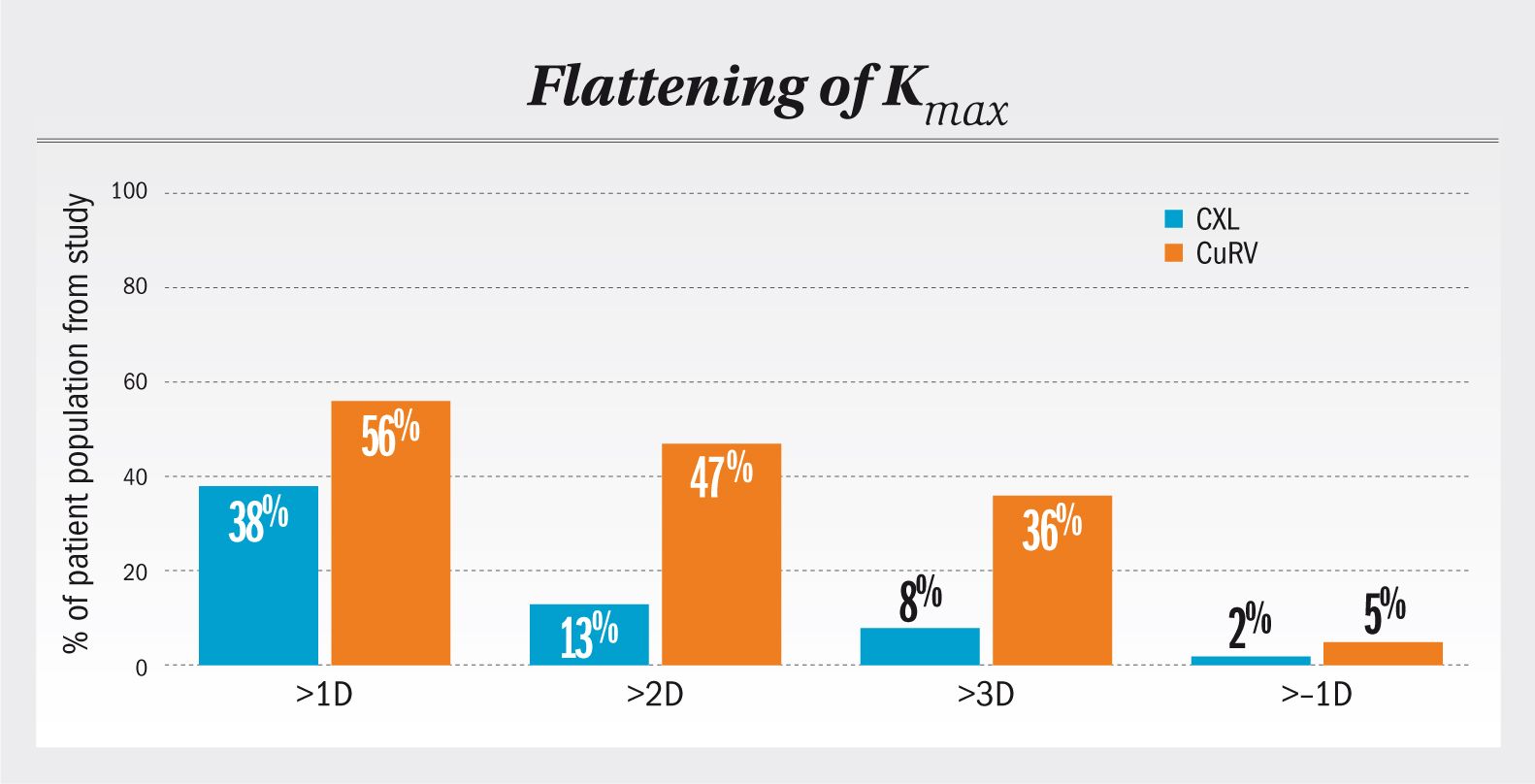Article
Customized CXL approach brings outcomes benefits
Author(s):
Customized corneal crosslinking for keratoconus focuses the treatment on the weak area of the cornea.

(Figure 1) Distribution of change in maximal K-readings in CuRV versus standard CXL: stronger flattening occurs more frequently in the CuRV group. (Data presented by Theo G. Seiler, MD, PhD, at ESCRS 2017; figure courtesy of Avedro)
By Cheryl Guttman Krader; Reviewed by Theo G. Seiler, MD, PhD
Custom crosslinking-an evolution of standard corneal cross-linking (CXL)-is customized to a patient’s specific corneal topography, and appears to result in greater normalization of cornea curvature for keratoconus than standard CXL treatment performed using the original Dresden protocol, said Theo G. Seiler, MD, PhD.
Customized CXL is a tomography-guided procedure that focuses the treatment on the weak area of the keratoconic cornea. The procedure, which Avedro has been marketing as CuRV, is performed using a proprietary adjustable ultraviolet A light device (Mosaic System, Avedro) that features an integrated eye tracker and enables projection of customized irradiation patterns with customized energy profiles onto the cornea.
The concept of performing customized CXL arose from findings of biomechanical modeling undertaken by Abhijit Sinha Roy, PhD, and William J. Dupps Jr., MD, PhD, who proposed that the biomechanical change in keratoconus is focal, not generalized [Invest Ophthalmol Vis Sci. 2011;52:9174-9187].
“Previously, it was thought that because keratoconus is a genetic disease, the defect would be present throughout the entire cornea, and therefore, the entire cornea would need to undergo CXL,” said Dr. Seiler, professor of ophthalmology, University of Zurich, and chairman, Institute for Refractive and Ophthalmic Surgery (IROC), Zurich, Switzerland.
Proof of concept for performing customized CXL was provided by a study conducted by Giuliano Scarcelli, PhD, and colleagues who evaluated the mechanical properties of keratoconic corneas using tissue removed during keratoplasty [Invest Ophthalmol Vis Sci. 2013;54:1418-1425]. Using Brillouin optical microscopy, they showed mechanical loss was generally localized to the area of the cone, whereas outside the cone the Brillouin shift was similar to that measured in healthy control eyes.
Clinical outcomes
To evaluate the efficacy and safety of customized CXL to treat progressive keratoconus, Dr. Seiler and colleagues conducted a comparative study that included data from 19 eyes treated with the new procedure and 100 control eyes that had standard CXL.
Results from analyses of data collected at 1-year post-treatment showed that the customized procedure had a significantly greater flattening effect and provided significantly better regularization of the cornea compared with the standard procedure. Mean change in Kmax for the customized and standard groups was –1.7 D and –0.9 D, respectively, and the mean regularization index values for the two groups were 5.2 D and 4.1 D, respectively.

“The regularization index is a term we introduced to describe the regularization of the corneal surface within a 6-mm circle around the cone,” Dr. Seiler said. “It is defined as the maximal steepening plus the maximal flattening on the corneal tomography difference map 1 year postoperatively compared with preoperatively.”
The comparison between the customized and standard CXL groups also showed that epithelial healing time was significantly shorter after the customized procedure than after the standard treatment, 2.56 versus 3.19 days, respectively.
“The shorter time to re-epithelialization is explained by the fact that the customized procedure involves a smaller abrasion zone than for standard CXL,” Dr. Seiler said.
Regardless of the approach used for CXL, not all eyes achieved a significant flattening effect, i.e., >1 D decrease from baseline Kmax. However, the percentage of eyes that had a >1 D decrease in Kmax was greater in the customized CXL group than after standard CXL, 56% versus 38%, respectively, while the percentage of eyes achieving >2 D of flattening was nearly fourfold higher in the customized group compared with the standard CXL group, 47% versus 13%, and the percentage achieving >3 D of flattening was 4.5 times greater with customized versus standard CXL, 36% versus 8%.
The ability to customize the CXL procedure opens the door to special applications. For instance, Dr. Seiler used the technique to treat a patient who had undergone penetrating keratoplasty for keratoconus and later presented with steepening of the cornea outside the area of the transplant. The patient refused another graft procedure, but underwent CXL using an annular pattern designed to stiffen only the area outside of the graft.
“The procedure was done just 3 months ago, and so I do not have any clinical data yet,” Dr. Seiler said. “However, the patient developed significant haze in his native cornea and that means we created the CXL effect.”
Looking ahead, Dr. Seiler said that it is also possible that customized CXL may be applied as a refractive procedure for spherical and astigmatic corrections in normal as well as in keratoconic corneas.
Theo G. Seiler, MD, PhD
e: theo.seiler@iroc.ch
This article was adapted from Dr. Seiler’s presentation at the 2017 meeting of the European Society of Cataract and Refractive Surgeons. Dr. Seiler is a consultant to Avedro.
Newsletter
Don’t miss out—get Ophthalmology Times updates on the latest clinical advancements and expert interviews, straight to your inbox.




